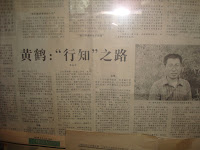 |
| The Stage and Conference Banner |
Greetings Fellow Travelers,
Sorry it’s taken us so long to post the first installment of our travels, but here goes!
We attended the First International Conference on Zheng He, in Melaka, Malaysia. The Conference title was “Zheng He and the Afro-Asian World.”
Why was the conference in Melaka?
When Zheng He arrived in Melaka, it strengthened Melaka’s position as a prosperous trade and international relations center, where traders from the Middle East, Africa, South East Asia, and East Asia came to trade. Zheng He had very friendly relationship with the Sultan of Melaka, and it was a regular stopping point for his ships on each one of his voyages.
The Conference was opened with a Bacaan Doa – a prayer in Malay language, given by Datuk Wira Haji Hamdin Bin Abdollah, Chairman of the Board of Directors of Perzim. Then there were several more welcome speeches: by Dr. Tan Ta Sen, the President of the International Zheng He Society, Tan Sri Tiong Hew Khing, President of the World Chinese Media Association, Professor Leo Suryadinata, Director of the Chinese Heritage Center in Singapore, and a lastly, a speech by the Tun Mohd Khalil Yaakob Governor of Melaka, who welcomed everyone to conference, and talked bout the importance of producing work for people to learn about Zheng He.
He’s a big fan of Zheng He, and told participants that he is a great admirer of Admiral Zheng He and has read every single publication and seen every documentary about him. He also told everyone he had read every single paper that was to be presented at the conference.
The Governor spoke about how Zheng He was a good Muslim, a scholar, and a man of integrity, who serves as a model of peace today. The governor spoke about modern Africa, the excavation of one of Zheng He’s ships that is happening today in partnership between China and East Africa. He was very happy about the title of the conference, and said he was looking forward to learning more about Africa’s connection to China. Other important points he spoke about were the importance of evidence in research, and his hope that at the end of the conference, more conclusive evidence will be available to people who want to learn more about Zheng He and his voyages. He said that all the scholarship and knowledge of Zheng He should be made available in many languages so that there is greater access for all people.
The Governor called Melaka as the melting pot of South East Asia: in Melaka there is a blend of languages, culture and people.
The conference program was printed in three different languages, and most of the speeches were given in four different languages, because of the diversity of the people attending the conference. The major languages spoken in this regions of the world are Mandarin, Malay, English, and Tamil.
The speeches were followed by drumming on a large drum like the ones used on Zheng He’s ships for communication between the ships 600 years ago.
Also on stage during the opening ceremonies was a man who is the 16th generation cousin of Zheng He.
The entire conference lasted four days. Some sessions were in Chinese, and others were in English. 400 people attended the conference!
One of the first presenters, Dr. Siu-leung Lee, is a famous calligrapher and scholar, and works on the Avatar TV Series.
History is always changing – as people find out new information, history changes. That’s why people continue to do research and to share new information that they have found out.
Here are some of the interesting topics about Zheng He and his connection to Africa that people have been researching:
- The population of Africans with Chinese ancestry on Pate Island (Kenya)
- Zheng He’s voyages to the Western Ocean and Communication between Afro-Asia
- Zheng He’s maps show his voyages contributed new knowledge and understanding about
geography and the African continent
- Zheng He’s contributions to the spread of Islam in the Malay world, and his legacy of an open-
minded, peaceful multi-ethnic, multi-relgious community.
- Good relationships he established with other peoples around the Indian Ocean
- Reconstructing one of Zheng He’s treasure ships in Nanjing from primary source documents about the measurements, design and materials
A special flag was designed for this conference:
On the front of the flag:
The character (He) is part of Zheng He’s name, and is the character for Peace and Harmony
The circle is an ancient Chinese calendar using a Chinese compass
The white color represents purity and honesty
The blue represents the ocean
On the back of the flag:
The treasure ship of Zheng He represents that this conference will be a platform for building up international understanding between nation and nation.
Monday night was the banquet to celebrate the first day of the conference. There was lots of delicious Malay food, followed by a cultural performance.
There were many different Malay dishes – here are some:
Mee goring (yellow noodles stir-fryed with vegetables and meat)
Chickeng Rendang – a spicy chicken curry
Laksa lemak – dish with prawn, tofu and egg
Lots of rice – cooked in coconut milk! Yum!
No pork was served – we haven’t seen any pork dishes on this trip at all. More than half of the population in Malaysia is Muslim – 16 million people!
For dessert:
Sago - a famous and popular Malay dessert, a kind of pudding with egg whites, palm sugar, coconut milk and red beans. It looks like tapioca [picture] – this was so good it was hard to stop eating it!!
There were also many beautiful fruits – durian, star fruit, dragon fruit, pineapple, papaya, and water apple.
Next installment: our presentation was a success!
~ Lucy and Alicia



































































